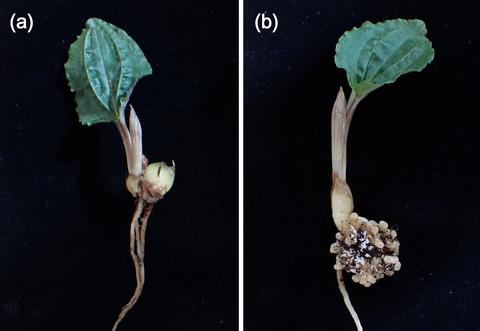当前位置:
X-MOL 学术
›
Funct. Ecol.
›
论文详情
Our official English website, www.x-mol.net, welcomes your feedback! (Note: you will need to create a separate account there.)
Subterranean morphology modulates the degree of mycoheterotrophy in a green orchid Calypso bulbosa exploiting wood-decaying fungi
Functional Ecology ( IF 5.2 ) Pub Date : 2021-06-19 , DOI: 10.1111/1365-2435.13864 Kenji Suetsugu 1 , Jun Matsubayashi 2
中文翻译:

地下形态调节利用木材腐烂真菌的绿兰花 Calypsobulboosa 的真菌异养程度
更新日期:2021-06-19
Functional Ecology ( IF 5.2 ) Pub Date : 2021-06-19 , DOI: 10.1111/1365-2435.13864 Kenji Suetsugu 1 , Jun Matsubayashi 2
Affiliation

|
- Many vascular plants and aquatic organisms are not strictly autotrophic or heterotrophic but rather mixotrophic. Mixotrophy is a widespread nutritional strategy, merging autotrophy and heterotrophy to acquire organic carbon (C). Because all orchids are mycoheterotrophic during the early stages, many species are also predisposed to mycoheterotrophic nutrition during the mature stage. Consequently, many green orchids adopt partially mycoheterotrophy, a kind of mixotrophic strategy, obtaining carbon through autotrophy and mycoheterotrophy. However, the proportions of fungal-derived carbon reported for these mixotrophic orchids show considerable variation, even within species under similar light conditions and at similar growth stages. The factors promoting such variation remain to be fully elucidated.
- We investigated the nutritional mode of a green orchid Calypso bulbosa to determine whether coralloid rhizomes, which are often found in fully mycoheterotrophic orchids, affect the degree of mycoheterotrophy. To this end, we performed molecular barcoding and 13C and 15N analyses to identify the mycorrhizal partners and fungal dependency of C. bulbosa specimens with and without coralloid rhizomes.
- We found that C. bulbosa individuals were consistently colonized by an OTU of the wood-decaying fungal genus Protomerulius (Auriculariales), regardless of the presence of rhizomes. Furthermore, although both types of C. bulbosa specimens are partially mycoheterotrophic, as indicated by their higher 13C and 15N abundances, those with coralloid rhizomes exhibited a higher degree of mycoheterotrophy. Our results indicate that partial mycoheterotrophy in C. bulbosa is a flexible mechanism driven by subterranean morphology.
- Although mixotrophy has evolved repeatedly in vascular plants and aquatic organisms, their trophic plasticity remains largely unexplored. Here we propose a novel mechanism modulating the degree of mycoheterotrophy in green orchids, providing a new perspective on the ecological plasticity of nutritional mode in mixotrophic organisms.
中文翻译:

地下形态调节利用木材腐烂真菌的绿兰花 Calypsobulboosa 的真菌异养程度
- 许多维管植物和水生生物并非严格自养或异养,而是混养。Mixotrophy 是一种广泛的营养策略,将自养和异养合并以获取有机碳 (C)。由于所有兰花在早期阶段都是真菌异养的,因此许多物种在成熟阶段也容易受到真菌异养营养的影响。因此,许多绿色兰花采用部分真菌异养,一种混合营养策略,通过自养和真菌异养获取碳。然而,这些混合营养兰花的真菌衍生碳的比例显示出相当大的变化,即使在相似光照条件和相似生长阶段的物种内也是如此。促进这种变异的因素仍有待充分阐明。
- 我们调查了绿色兰花的营养模式卡吕普索bulbosa确定珊瑚状根茎,这往往是在完全mycoheterotrophic兰花发现,是否会影响mycoheterotrophy的程度。为此,我们进行了分子条形码和13 C 和15 N 分析,以识别具有和不具有珊瑚状根茎的球茎球藻标本的菌根伙伴和真菌依赖性。
- 我们发现,无论根状茎是否存在,球茎球藻个体始终被木材腐烂真菌属Protomerulius (Auriculariales)的 OTU 定殖。此外,尽管两种类型的球茎 C.bulboosa标本都是部分真菌异养的,如其较高的13 C 和15 N 丰度所示,但那些具有珊瑚状根状茎的标本表现出更高程度的真菌异养。我们的结果表明,球茎球藻中的部分真菌异养是一种由地下形态驱动的灵活机制。
- 尽管混合营养在维管植物和水生生物中反复进化,但它们的营养可塑性在很大程度上仍未得到探索。在这里,我们提出了一种调节绿色兰花真菌异养程度的新机制,为混合营养生物营养模式的生态可塑性提供了新的视角。



























 京公网安备 11010802027423号
京公网安备 11010802027423号